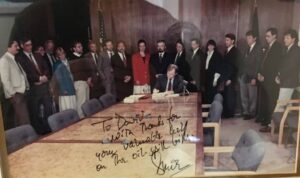Alaska House Bill 567 turns 30

It’s almost hard to believe it’s been more than 30 years since the Exxon Valdez oil spill. One reason is because the work done since then has prevented a slide back into complacency by continuing to apply the lessons learned in the immediate aftermath of the spill.
Exxon Valdez spurred both federal and state legislatures, the industry, and the public to come together to establish laws protecting sensitive resources from another spill. One of those, Alaska House Bill 567, celebrated its 30th anniversary on June 25th. This law created, among other things, Alaska’s world class set of spill response regulations.
Federal legislation would reinforce these principles in 1990, when the Cook Inlet Regional Citizens Advisory Council (CIRCAC) was created. We represent 13 diverse groups from Kodiak to Anchorage including Alaska Native groups, municipal governments and public interests like fishing, tourism, aquaculture, recreation and environmental concerns. We work closely with regulators and the industry to ensure not only that those interests are recognized and accounted for in response planning, but also to keep the public informed about issues that could potentially compromise the ability to effectively respond to an incident.
When it was clear that the planned response to Exxon Valdez was woefully inadequate to the unprecedented scope of the spill, the Alaska Department of Environmental Conservation took a lead role in adapting response strategy to meet those challenges. The end result was the most comprehensive suite of oil spill response strategies ever imagined. We remain committed to those laws and over the ensuing 30 years, we have worked to add strength and clarity to them.
When Governor Steve Cowper finally signed HB 567 into law in the waning hours of the legislative session on June 27th, 1990, the bill’s passage signaled that opposing interests could come together in relatively short order, and under great pressure, to do the right thing. That is a lesson that can never be taught enough, even after 30 years.
Our work with industry and regulators over the decades has prevented a slow drift into complacency by continuing to identify potential risks, recognizing new technologies, and always seeking more clarity. That attention to detail is what maintains confidence in response plans and builds on a unique component of HB 567; that these rules should be self-executing and offer accountability and detailed plans for how to effectively respond to virtually any challenge.
Learn more about the history of House Bill 567 here.










